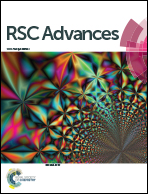A mechanically improved virus-based hybrid scaffold for bone tissue regeneration
Abstract
Appropriate mechanical and outstanding biological properties of biomedical scaffolds are prerequisites to successfully regenerate bone tissues. Here, we designed a hybrid scaffold consisting of microsized core–sheath struts based on chemically conjugated M13 bacteriophage (phage)/alginate and poly(ε-caprolactone) (PCL). The filamentous phages were modified with the Arg-Gly-Asp (RGD) sequence and calcium-binding sites. The hybrid scaffold was a mesh-like core (PCL)–sheath (phage/alginate) structure (strut size = 434 ± 51 μm, pore size = 495 ± 23 μm, with completely interconnected pores). To evaluate the mechanical and in vitro biological properties using osteoblast-like (MG63) cells, we used two controls: pure alginate and RGD-modified alginate (R-A). The scaffolds were analyzed for various mechanical properties and biological activities (tensile property, protein absorption ability, biomineralization, in vitro cell responses, and osteogenic gene expression). The biomineralization and protein absorption ability of the hybrid scaffold were significantly higher than those of the R-A. Furthermore, the proliferation of viable cells and the level of osteogenic gene expression (alkaline phosphatase activity) of the hybrid scaffold using the chemically conjugated phage/alginate were significantly enhanced compared with the control scaffolds. Based on these results, we suggest that the M13 phage/PCL-based hybrid scaffold may have potential as a biomedical scaffold for use in bone tissue regeneration.


 Please wait while we load your content...
Please wait while we load your content...